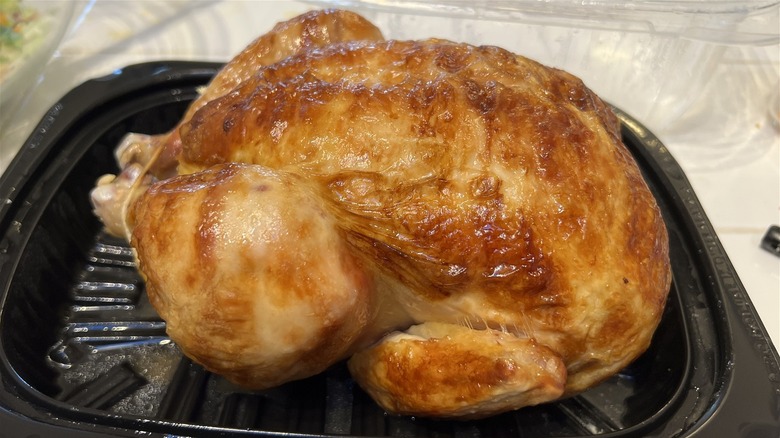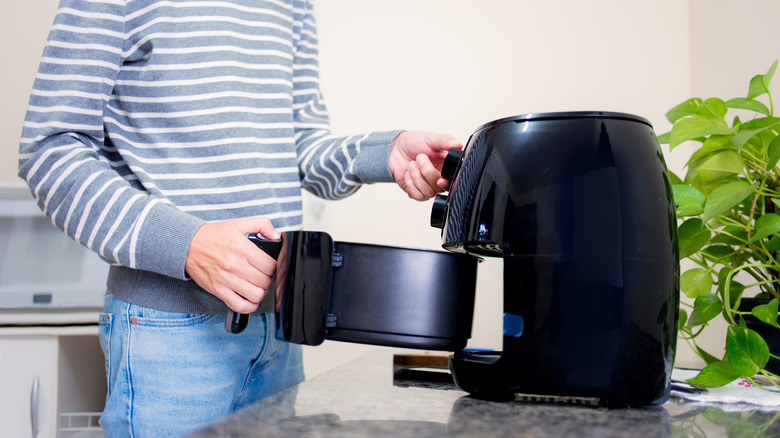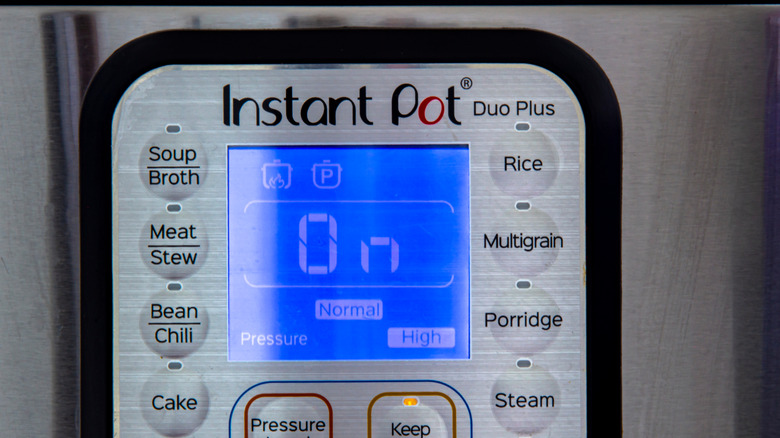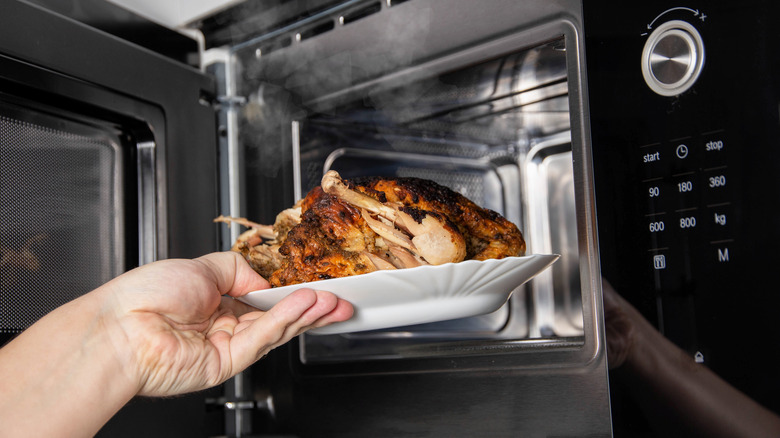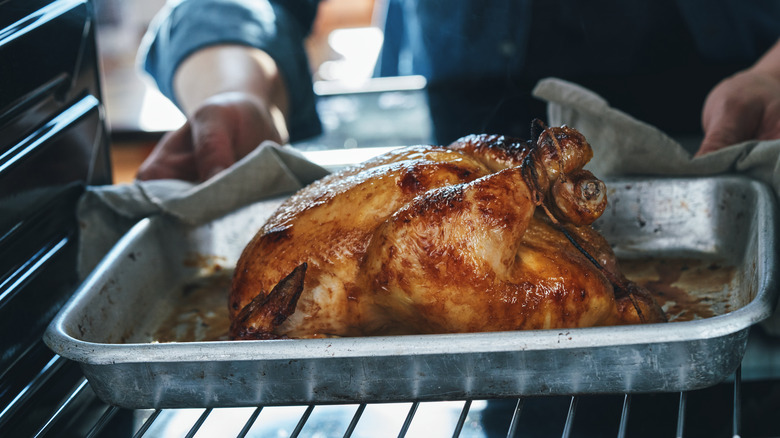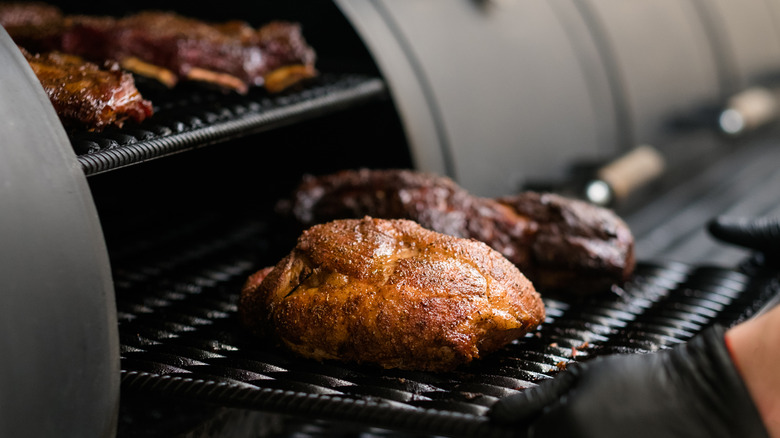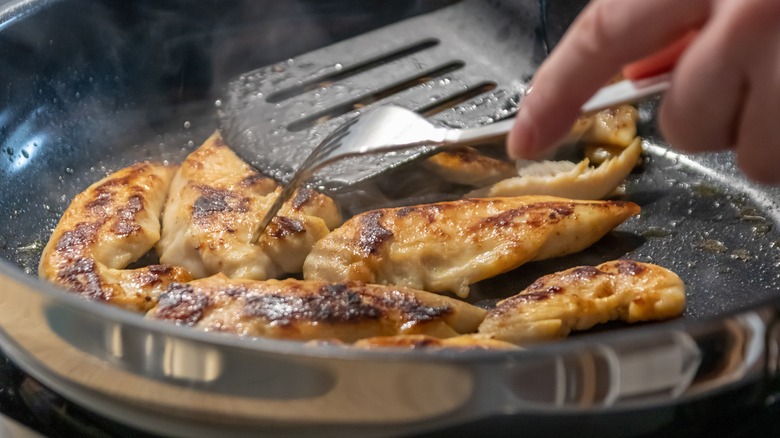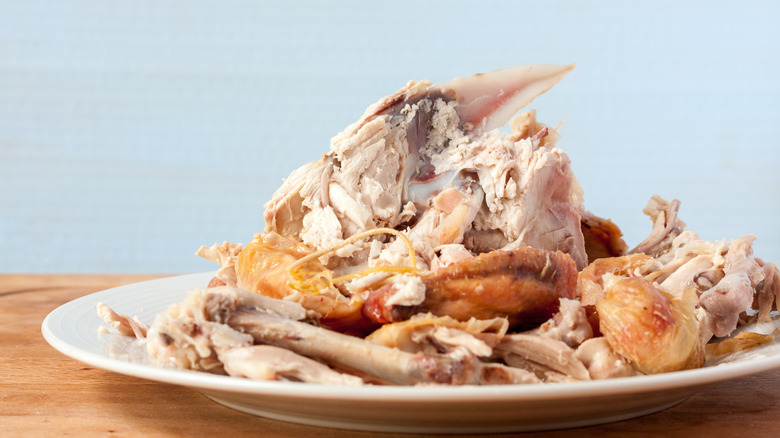How To Reheat A Costco Rotisserie Chicken 6 Ways
Picking up a rotisserie chicken when you're out grocery shopping, whether it be at Costco or any of the numerous other establishments that sell these birds, can be a great time saver, but there is one teeny-tiny problem. Either you need to live pretty close to the store and time your shopping trip just right or else plan on cold chicken for dinner, although there's actually nothing wrong with that. Cold chicken and a side salad, plus maybe some rolls and butter, would make for a lovely meal.
Assuming you would rather eat hot chicken and your Costco (or other) grocery run took longer than expected, though, you'll probably want to reheat that rotisserie bird once you get it home. This applies double if you go out shopping early in the day and need to stick the chicken in the refrigerator for several hours before you're ready for dinner since cooked chicken can only sit out on the counter for two hours max (one if the temperature is 90 F or above) before you run the risk of it breeding harmful bacteria. Whether your chicken is room temperature or fresh out of the fridge, there are several different ways you can heat it back up again. We're presenting them here in alphabetical order since it's up to you to pick your favorite one. (Spoiler: They all work just fine, assuming you have the necessary appliances.)
In the air fryer
If you have an air fryer that is large enough to hold an entire rotisserie chicken, you can use it to reheat the whole bird. A medium-sized machine should work since Costco's hardly going to be selling Jersey Giants for under $5 and its average chicken weighs in around 3 pounds.) If your air fryer is on the small side, though, you can always cut it up in pieces.
Depending on how warm you want your chicken to be and how crispy the skin is, you may opt to cook it for as little as 3 minutes at 350 F, although preheating the appliance will obviously tack on some time. Some, however, may choose to cook the chicken for up to 20 minutes, although it's probably best to keep checking every few minutes to ensure that the meat doesn't dry out entirely. You can also reheat the chicken at 400 F, which may be best for chicken cut into pieces. While air frying your chicken may or may not be a time saver, depending on how much reheating you feel it needs and how long it takes your unit to heat up, it will give the chicken a nice crunchy skin.
In the Instant Pot
If you reheat rotisserie chicken in an Instant Pot, however, the skin most definitely won't be crisp, but the payoff is that the meat is unlikely to dry out. The reason the chicken retains (or gains) so much moisture is that you'll be adding water or broth to the pot so it will steam as it pressure cooks.
The Instant Pot method of reheating, despite the appliance's name, really isn't one of the quicker ways to do it, although at least you won't need to preheat the pot. Instead, you just pour in a cup of liquid, put the trivet in place, then plop the chicken on top. Some cooks say to wrap it in foil first, but this seems to be an optional step. Close the lid and set it to steam cook for 10 minutes or maybe just five if you're only doing a small portion.
Once the chicken is heated to your satisfaction, you'll need to perform a quick pressure release so the steam can escape without burning you once you open the lid. Don't throw out the liquid, though, as this can be saved as chicken broth. You could also use it right away to make a quick gravy by adding a little fat, salt, and flour.
In the microwave
The microwave may be the quickest, easiest way to reheat rotisserie chicken, but there is one significant caveat. As cookbook author and chef Kelli Lewton tells Parade, microwaved bone-in chicken doesn't heat up evenly since the bones get hot more quickly than the meat. A quick way to take care of this is to cut off the amount of chicken you want to eat while the bird is still cold and unable to burn your fingers. Put it on a plate (a microwave-safe one, of course), cover it with a damp paper towel, then zap it for a couple of minutes.
If you're looking to go a more labor-intensive route, however, Lewton herself recommends wrapping the chicken in plastic and then microwaving it at 60% power for the same amount of time. Once it's hot, you'll then need to cut it off the bones, put the boneless chicken on a plate, and nuke it at 80% for a few more minutes.
In the oven
Reheating your rotisserie chicken in the oven may be one of the more time-consuming ways as it takes around half an hour plus preheating time, which in itself can take up to 15 minutes. Still, this method of cooking can bring you the best of both worlds with crispy skin and juicy meat. To keep the chicken moist (sorry we had to use that word, but we already went with "juicy" and somehow damp, dank, or soggy chicken sounds even less appealing), you will need to pour some liquid into the baking pan — 4 to 8 ounces of water or broth ought to do the trick. Cover the chicken with foil as this will trap the steam from the liquid, then bake it at 350 F for about 25 minutes or so. (Since all you are doing is reheating an already-cooked chicken, time is not of the essence in the same way that it would be for a raw bird.)
As for ensuring that the skin retains a little crunch to it, that is done by taking the foil cover off so the chicken can dry cook for another 5 to 8 minutes. For extra flavor and crispness, you can even rub some butter or bacon drippings over the skin.
In a smoker
While reheating a rotisserie chicken in the oven may be fairly time-consuming, the slowest way of all may be to throw it on your smoker. This latter method is somewhat risky as smoking pre-cooked meat can tend to dry it out, but the payoff is that the wood smoke will add the kind of flavor that could never come from a rotisserie grill alone.
Smokers vary pretty widely from one to another so there aren't any hard and fast rules for smoking a rotisserie chicken as regards time and temperature, but for the most part, you're going to want to keep the former fairly short and the latter fairly low (perhaps about 325 F). Use a meat thermometer and remove the chicken when the internal temperature hits 165. In this case, it's not for food safety's sake as the chicken is already cooked, but instead marks the point at which the chicken will really start to get dry. Keep an eye on the skin, too — once it gets quite crunchy, that's another sign that you should take the chicken off the heat.
On the stove top
If you choose to reheat your rotisserie chicken on the stovetop, as well you might if you'd prefer to avoid heating up the kitchen or waiting for the oven to preheat, you'll need to cut the meat off the bones. You can go ahead and shred the chicken, too, if you plan to use it right away as a nacho topper or taco filling or if you like warm chicken on your salad.
Once you've chopped your chicken, grease a frying pan with a small amount of oil. You won't need a lot, just enough to coat the pan and ensure that the chicken won't stick. (Cooking spray may also be used.) Bear in mind, there may be some additional grease from the chicken itself as rotisserie chickens tend to have a fair amount of fat. Crank the burner up to medium-high, heat the pan, then dump in the de-boned chicken and stir-fry it for maybe five minutes or so until all of it has warmed up to the point where you're willing to eat it.
What to make with leftover rotisserie chicken
If you don't eat all of your rotisserie chicken on the day you bring it home from the store, take note: The USDA says that rotisserie chicken is only good for 4 days in the refrigerator, so you'll either need to repurpose it within that time frame or else store it in the freezer. Should you choose the latter approach, we have a number of different recipes that may be of interest.
If you're in the mood for chicken soup (whether or not you have a cold), you can use your rotisserie leftovers in this aptly-named leftover rotisserie chicken soup or, if you're in a hurry, this 20-minute chicken noodle soup. If you'd prefer to make a casserole, we've got quite a few recipes that call for leftover cooked chicken, including a chicken bacon ranch one, another that mixes chicken and stuffing in one pan, a dish of creamy chicken stuffed shells, and a retro '70s recipe called Nixon chicken (or, as we prefer to call it, Tricky Dicky Chickie). A number of Mexican-inspired dishes, too, can be made with rotisserie leftovers, including our slow cooker enchiladas and sheet pan chicken nachos. If none of these recipes is exactly what you're looking for, though, feel free to use them as templates and riff on them to come up with your own personal spin.
